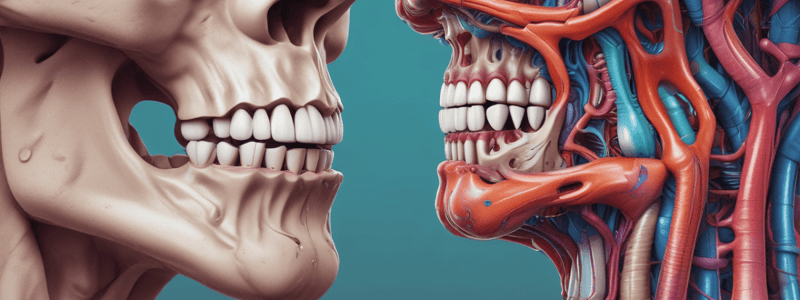Podcast
Questions and Answers
What is the primary function of the larynx?
What is the primary function of the larynx?
- Regulating body temperature
- Facilitating gas exchange
- Playing a role in voice production and airway protection (correct)
- Producing insulin
Which cartilage forms a complete ring around the airway in the respiratory tract?
Which cartilage forms a complete ring around the airway in the respiratory tract?
- Epiglottic cartilage
- Thyroid cartilage
- Hyoid bone
- Cricoid cartilage (correct)
Which nerve innervates the larynx and has a course that wraps around the aortic arch on the left side and subclavian artery on the right side?
Which nerve innervates the larynx and has a course that wraps around the aortic arch on the left side and subclavian artery on the right side?
- Hypoglossal nerve
- Vagus nerve (correct)
- Glossopharyngeal nerve
- Accessory nerve
Which structure consists of two laminae that fuse at an angle to form the Adam's Apple?
Which structure consists of two laminae that fuse at an angle to form the Adam's Apple?
How many cartilages join to form the laryngeal skeleton?
How many cartilages join to form the laryngeal skeleton?
Which of the following functions are associated with the larynx?
Which of the following functions are associated with the larynx?
What structure forms the superior opening of the larynx?
What structure forms the superior opening of the larynx?
Which ligament is NOT part of the vocal apparatus?
Which ligament is NOT part of the vocal apparatus?
What is the main function of the cricothyroid muscle?
What is the main function of the cricothyroid muscle?
Which nerve innervates the sensory aspect of the vocal folds?
Which nerve innervates the sensory aspect of the vocal folds?
What is the function of the vestibular folds in the larynx?
What is the function of the vestibular folds in the larynx?
Where is the infraglottic cavity located?
Where is the infraglottic cavity located?
What is the function of the primary ligament that connects the cricoid to the thyroid cartilage?
What is the function of the primary ligament that connects the cricoid to the thyroid cartilage?
Which structure extends between the lateral aspects of the arytenoid and epiglottic cartilages?
Which structure extends between the lateral aspects of the arytenoid and epiglottic cartilages?
Which of the following is NOT a function of the thyroid cartilage?
Which of the following is NOT a function of the thyroid cartilage?
Where does the median cricothyroid ligament connect?
Where does the median cricothyroid ligament connect?
Which structure is composed of a fibro-elastic membrane and aids in phonation?
Which structure is composed of a fibro-elastic membrane and aids in phonation?
What is the main role of the quadrangular membrane in the larynx?
What is the main role of the quadrangular membrane in the larynx?
What is the function of the tympanic membrane in the ear?
What is the function of the tympanic membrane in the ear?
Which muscles are responsible for controlling sound conduction in the middle ear?
Which muscles are responsible for controlling sound conduction in the middle ear?
Which nerve is responsible for innervating the Vestibulocochlear Organ in the inner ear?
Which nerve is responsible for innervating the Vestibulocochlear Organ in the inner ear?
Which structure is responsible for balance and position in the inner ear?
Which structure is responsible for balance and position in the inner ear?
What is the function of the auricle in the ear?
What is the function of the auricle in the ear?
Which bones make up the ossicles chain in the middle ear?
Which bones make up the ossicles chain in the middle ear?
Which muscle paralysis results in a monotone voice?
Which muscle paralysis results in a monotone voice?
What is the consequence of a unilateral injury to the recurrent laryngeal nerve?
What is the consequence of a unilateral injury to the recurrent laryngeal nerve?
Which nerve provides motor innervation to the cricothyroid muscle?
Which nerve provides motor innervation to the cricothyroid muscle?
What symptom arises from paralysis of the cricothyroid muscle?
What symptom arises from paralysis of the cricothyroid muscle?
How does bilateral lesion of the recurrent laryngeal nerve affect breathing?
How does bilateral lesion of the recurrent laryngeal nerve affect breathing?
What is the function of the external (outer) ear?
What is the function of the external (outer) ear?
Match the following structures with their correct location within the larynx:
Match the following structures with their correct location within the larynx:
Match the following ligaments with their associated structures in the larynx:
Match the following ligaments with their associated structures in the larynx:
Match the following arteries with their branches involved in laryngeal innervation:
Match the following arteries with their branches involved in laryngeal innervation:
Match the following muscle actions with their corresponding functions in the larynx:
Match the following muscle actions with their corresponding functions in the larynx:
Match the following structures with their correct descriptions in the larynx:
Match the following structures with their correct descriptions in the larynx:
Match the following functions with the corresponding laryngeal structures:
Match the following functions with the corresponding laryngeal structures:
Match the following nerve-related descriptions with their effects on voice production:
Match the following nerve-related descriptions with their effects on voice production:
Match the following nerves with their functions in the larynx:
Match the following nerves with their functions in the larynx:
Match the following structures with their functions in the ear:
Match the following structures with their functions in the ear:
Match the following structures with their main functions:
Match the following structures with their main functions:
Match the following ear structures with their primary functions:
Match the following ear structures with their primary functions:
Match the following middle ear components with their functions:
Match the following middle ear components with their functions:
Match the following nerves with their innervation targets in the ear:
Match the following nerves with their innervation targets in the ear:




